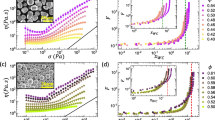Abstract
This work proposes a continuum-mechanical model of cell motility which accounts for the dynamics of motility-relevant protein species. For the special case of fish epidermal keratocytes, the stress and cell-substrate traction responses are postulated to depend on selected protein densities in accordance with the structural features of the cells. A one-dimensional version of the model is implemented using Arbitrary Lagrangian–Eulerian finite elements in conjunction with Lagrange multipliers for the treatment of kinematic constraints related to surface growth. Representative numerical tests demonstrate the capacity of the proposed model to simulate stationary and steady crawling states.
Similar content being viewed by others
References
Asai H (1974) Diffusion process of myosin and utilization of ATP energy in F-actin solution. J Phys Soc Jpn 36(4): 1114–1120
Bao G, Suresh S (2003) Cell and molecular mechanics of biological materials. Nat Mater 2(11): 715–725
Bausch AR, Kroy K (2006) A bottom-up approach to cell mechanics. Nat Phys 2(4): 231–238
Bausch AR, Ziemann F, Boulbitch AA, Jacobson K, Sackmann E (1998) Local measurements of viscoelastic parameters of adherent cell surfaces by magnetic bead microrheometry. Biophys J 75(4): 2038–2049
Benson DJ (1992) Computational methods in Lagrangian and Eulerian hydrocodes. Comput Methods Appl Mech Eng 99(2–3): 235–394
Bray D (2001) Cell movements: from molecules to motility, 2nd edn. Garland Publishing, New York
Choi YS, Lee J, Lui R (2004) Traveling wave solutions for a one-dimensional crawling nematode sperm cell model. J Math Biol 49(3): 310–328
Cooper MS, Schliwa M (1986) Motility of cultured fish epidermal cells in the presence and absence of direct current electric fields. J Cell Biol 102(4): 1384–1399
Demmel J (1997) Applied numerical linear algebra. SIAM, Philadelphia
Demmel JW, Eisenstat SC, Gilbert JR, Li XS, Liu JWH (1999) A supernodal approach to sparse partial pivoting. SIAM J Matrix Anal Appl 20(3): 720–755
DiMilla PA, Barbee K, Lauffenburger DA (1991) Mathematical model for the effects of adhesion and mechanics on cell migration speed. Biophys J 60(1): 15–37
Donea J (1983) Arbitrary Lagrangian-Eulerian finite element methods. In: Belytschko T, Hughes TJR (eds) Computational methods for transient analysis. North-Holland, Amsterdam, pp 473–516
Garlick PJ, McNurlan MA, Preedy VR (1980) A rapid and convenient technique fo measuring the rate of protein synthesis in tissues by injection of [3H] phenylalanine. Biochem J 192(2): 719–723
Gracheva ME, Othmer HG (2004) A continuum model of motility in ameboid cells. Bull Math Biol 66(1): 167–193
Herant M, Dembo M (2010) Form and function in cell motility: from fibroblasts to keratocytes. Biophys J 98(8): 1408–1417
Hodge N, Papadopoulos P (2010) A continuum theory of surface growth. Proc R Soc A: Math Phys Eng Sci 466(2123): 3135–3152
Holzapfel GA (2000) Nonlinear solid mechanics: a continuum approach for engineering. Wiley, New York
Kuusela E, Alt W (2008) Continuum model of cell adhesion and migration. J Math Biol 58(1–2): 135–161
Larripa K, Mogilner A (2006) Transport of a 1D viscoelastic actin-myosin strip of gel as a model of a crawling cell. Phys A 372: 113–123
Maree AFM, Jilkine A, Dawes A, Grieneisen VA, Edelstein-Keshet L (2006) Polarization and movement of keratocytes: a multiscale modelling approach. Bull Math Biol 68(5): 1169–1211
Marsden JE, Hughes TJR (1994) Mathematical foundations of elasticity. Dover, New York
Mogilner A, Keren K (2009) The shape of motile cells. Curr Biol 19(17): R762–R771
Newmark NM (1959) Method of computation for structural dynamics. American Society of Civil Engineers: Proceedings 85(EM3, Part 1):67–94
Nishimura SI, Ueda M, Sasai M (2009) Cortical factor feedback model for cellular locomotion and cytofission. PLoS Comput Biol 5(3): e1000310
Palecek SP, Loftus JC, Ginsberg MH, Lauffenburger DA, Horwitz AF (1997) Integrin-ligand binding properties govern cell migration speed through cell-substratum adhesiveness. Nature 385(6616): 537–540
Pollard TD, Borisy GG (2003) Cellular motility driven by assembly and disassembly of actin filaments. Cell 112(4): 453–465
Ragsdale GK, Phelps J, Luby-Phelps K (1997) Viscoelastic response of fibroblasts to tension transmitted through adherens junctions. Biophys J 73(5): 2798–2808
Rubinstein B, Jacobson K, Mogilner A (2005) Multiscale two-dimensional modeling of a motile simple-shaped cell. Multiscale Model Simul 3(2): 413–439
Rubinstein B, Fournier MF, Jacobson K, Verkhovsky AB, Mogilner A (2009) Actin-myosin viscoelastic flow in the keratocyte lamellipod. Biophys J 97(7): 1853–1863
Schmidt FG, Ziemann F, Sackmann E (1996) Shear field mapping in actin networks by using magnetic tweezers. Eur Biophys J 24(5): 348–353
Shao D, Rappel W, Levine H (2010) Computational model for cell morphodynamics. Phys Rev Lett 105(10): 108104
Simo JC (1987) On a fully three-dimensional finite-strain viscoelastic damage model: formulation and computational aspects. Comput Methods Appl Mech Eng 60(2): 153–173
Stricker J, Falzone T, Gardel ML (2010) Mechanics of the F-actin cytoskeleton. J Biomech 43(1): 9–14
Svitkina TM, Verkhovsky AB, McQuade KM, Borisy GG (1997) Analysis of the actin-myosin II system in fish epidermal keratocytes: mechanism of cell body translocation. J Cell Biol 139(2): 397–415
Verkhovsky AB, Svitkina TM, Borisy GG (1999) Self-polarization and directional motility of cytoplasm. Curr Biol 9(1): 11–20
Washizu K (1982) Variational methods in elasticity and plasticity, 3rd edn. Pergamon Press, Oxford
Webb DJ, Parsons JT, Horwitz AF (2002) Adhesion assembly, disassembly and turnover in migrating cells—over and over and over again. Nat Cell Biol 4(4): E97–E100
Zienkiewicz OC, Taylor RL, Sherwin SJ, Peiro J (2003) On discontinuous Galerkin methods. Int J Numer Methods Eng 58(8): 1119–1148
Author information
Authors and Affiliations
Corresponding author
Rights and permissions
About this article
Cite this article
Hodge, N., Papadopoulos, P. Continuum modeling and numerical simulation of cell motility. J. Math. Biol. 64, 1253–1279 (2012). https://doi.org/10.1007/s00285-011-0446-0
Received:
Revised:
Published:
Issue Date:
DOI: https://doi.org/10.1007/s00285-011-0446-0
Keywords
- Cell motility
- Surface growth
- Fish epidermal keratocyte
- Finite elements
- Arbitrary Lagrangian–Eulerian
- Strong discontinuity




